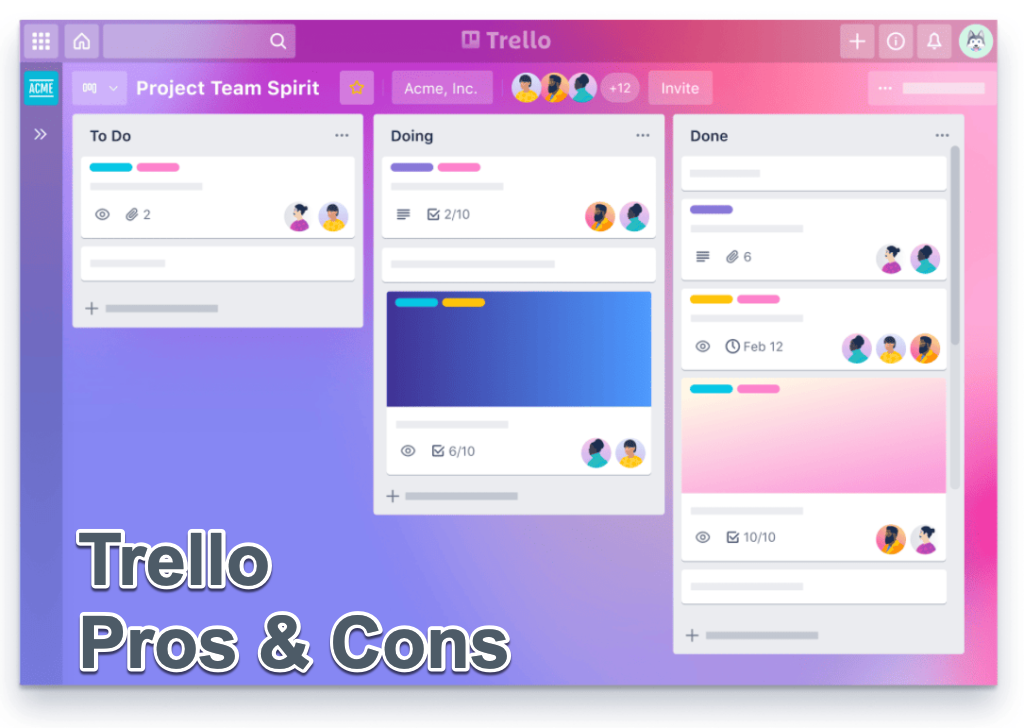
The widespread adoption of Trello as a premier online project management tool is no coincidence; it directly results from its undeniable advantages. Trello empowers its users with unparalleled collaborative capabilities, allowing seamless project task management without the hassle of juggling multiple apps.
The platform’s intuitive design ensures that users are fully informed about task assignments and their progress at a glance. Moreover, the effortless maneuverability of tasks across the platform isn’t just a convenience; it’s a strategic feature that visually maps out the entire project’s journey toward completion.

If you need an advanced reporting and exporting platform to boost Trello’s capabilities, consider our tool Bridge24 for Trello.
Trello Cons and Disadvantages
1. Insufficient Advanced Features
Trello lacks advanced project management tools. Essential features like time tracking, Gantt charts, and comprehensive reporting tools are conspicuously absent, posing significant challenges for complex project management.
2. Scalability Concerns
Trello’s simplistic approach can become a bottleneck for larger organizations or teams juggling multiple projects. Its structure may struggle to efficiently handle a high volume of tasks and team members, raising questions about its scalability.
3. Dependency on External Integrations
Users seeking enhanced functionality are often compelled to depend on third-party integrations. This reliance can introduce compatibility issues and additional costs, complicating a straightforward process.
4. Limited Customizability
The very simplicity that makes Trello appealing can also be its Achilles’ heel. Teams requiring a higher degree of customization to suit specific workflows will find Trello’s customization options lacking, restricting its adaptability.
5. Data Security Concerns
Being a cloud-based solution, Trello’s approach to data storage raises flags for data privacy and security. Trello’s external server storage may not be ideal for organizations with stringent security requirements or those handling sensitive data.
6. Challenging for Non-Technical Users
Trello’s interface, heavily reliant on boards, lists, and cards, can be daunting for non-technical users or those new to Kanban-style management. This complexity can steepen the learning curve unnecessarily.
7. Limited Offline Capabilities
As a predominantly web-based tool, Trello’s functionality takes a hit when offline. This limitation is a significant drawback for users needing consistent access in areas with poor internet connectivity.
8. Risk of Information Overload
Trello’s ability to accommodate detailed card information can backfire, leading to a cluttered interface. This excess of information can obscure high-priority tasks, complicating project management rather than simplifying it.
Trello Pros and Advantages
1. Instantaneous Real-Time Updates
Trello operates in real-time, ensuring seamless collaboration. Any update is instantly reflected across the system, eliminating delays and keeping all members on the same page.
2. Effortless Member Addition
Adding new members to a project in Trello is as simple as entering their email addresses. This ease of expansion streamlines team growth and collaboration.
3. Adaptive Responsive Design
Whether accessed from a laptop, smartphone, or tablet, Trello’s responsive design guarantees a consistent user experience. This flexibility means switching devices, from a computer to a phone, for instance, won’t hinder your ability to use Trello efficiently.
4. Efficient Kanban System
Trello’s implementation of the Kanban system, pioneered by Toyota in the 1950s, revolutionizes task management. It allows users to easily break down projects into manageable tasks using its intuitive board system.
5. Superior Notification System
Trello’s notification system is exemplary. It informs users about every action within the software – from updates to comments and task removals – with email notifications and push alerts for mobile users.
6. Simple and Affordable Pricing
Trello’s pricing structure is straightforward and budget-friendly. For just $25, users gain unlimited access, accommodating an unlimited number of users and a plethora of features, making it a value-packed choice.
7. Eliminates the Need for Physical Notes
Trello isn’t just practical; it’s also eco-friendly. Digitalizing the note-taking process helps users ditch paper notes, ensuring all tasks are remembered and managed digitally.
8. Exceptional User-Friendliness
Trello’s design is intuitive and user-friendly, catering to users of all skill levels. Its interface is so straightforward that even beginners can easily navigate it, making project management accessible to everyone.
Conclusion
Trello is a robust task management tool with numerous features to enhance work organization. The platform’s sleek and straightforward design can revolutionize project management and team coordination with minimal effort. Considering the advantages and disadvantages above, users can decide whether Trello is appropriate for their project management or productivity requirements.
Suggested article: The Pros and Cons of Using Trello Software
Hello! Looking through this post, it appears as if the pros and cons have accidentally been swapped. I did enjoy the content though. Thank you for compiling this list, I found it very useful 🙂
Thank you, Desteny. I corrected the post. The Pros and Cons are now in the correct order.